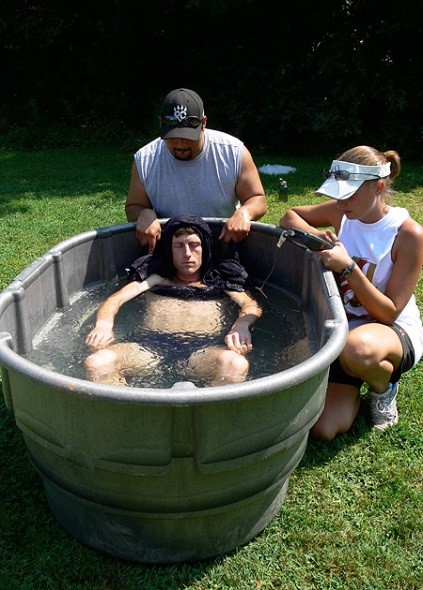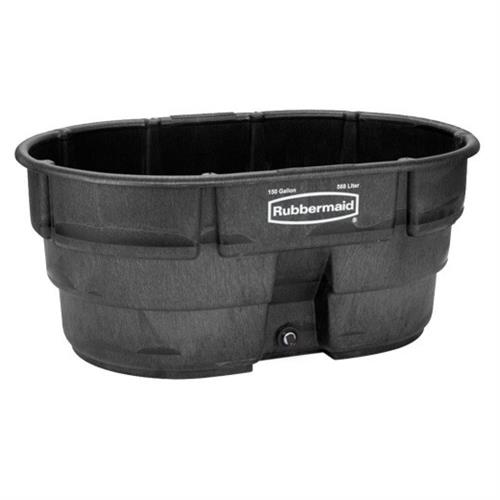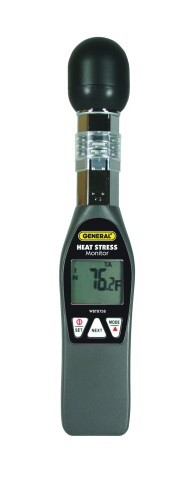
Illness | Signs & Symptoms | Treatment |
|---|---|---|
Heat Cramps- painful involuntary muscle spasm | · Normal pulse and respirations · Profuse sweating · Dizziness | · Rest in cool place · Increase water intake · Increase electrolytes |
Heat Syncope- causes person to feel faint or to faint while in hot temperature | · Elevated skin and core temperature · Fainting or feeling fait · Weakness · Fatigue · Blurred vision | · Get in cool shaded area · Increase water intake · Elevate legs |
Heat Exhaustion- unacclimated and increased exercise while in hot temperature | · Thirst · Profuse sweating · Weakness · Confusion · Rapid and shallow breathing · Weak pulse | · Move to cool shaded area · Remove unnecessary equipment · Cool athlete will ice towels or ice bags |
Heat Stroke- MEDICAL EMERGENCY | · Disoriented · May be unconscious · Increase body temperature (can only be measure by rectal core temp.) · Rapid strong pulse · Possibly no sweating · Shallow breathing · Could have altered behavior pattern (I.e. Erratic) · Central Nervous System dysfunction | · CALL 911 · Move to cool shaded area · Initiate rapid cooling of body in Cold water immersion in Rubbermaid immersion tub |
What is Cold Water Immersion (CWI)?
Treatment used for Heat Stroke, when a student athlete is suspected to be suffering.
Steps to Perform Cold Water Immersion for athlete in heat stroke:
Remove all unnecessary equipment
Fill Rubbermaid tub with enough water to immerse athletes entire body (on days when the WBGT measures above 82* the tub should be filled prior to practice/ games)
Monitor student athlete’s vitals and measure rectal core temperature; if temperature is above 105* begin cold water immersion
Place athlete in tub while filling if not already filled, spray the water on them to begin cooling them.
Place towel under athletes arm in order to hold their head up out of the water
Add ice to cool the water temperature down to 60* F
Have another helper stir the water with their hand to keep cold water moving around the athlete’s body. Athletes body temperature will heat up the water.
Athlete is kept in cold water immersion until rectal core body temperature is below 102*, if unable to measure rectal temperature keep athlete in CWI until shivering or EMS arrives and is ready to transport.
Athlete should always be cooled first then transported!


What is Wet Bulb Globe Thermometer (WBGT)?
WBGT is an instrument used measure heat stress similar to the sling psychomotor in the old days.
Athletic trainers will monitor environmental conditions via a Wet Bulb Globe Temperature Reading: It is required that the school based athletic trainer utilize a portable WBGT device and record the daily reading approximately one-half hour prior to afternoon practices. This recorded information should be made available to outdoor sport head coaches through one of several communication methods, including but not limited to: SMS texting, email, phone, or posting on athletic website. This reading should be taken whenever the forecasted outside temperature will exceed 85 degrees F and should be repeated hourly if temperature is expected to increase. Athletic trainers must utilize the DCPS Heat Measurement and Recording Form available from the athletic department website or through the JSMP.
The following activity guidelines are published for the athletic directors to share with coaches along with daily WBGT readings:

WBGT Reading |
| Activity Guideline and Rest Breaks |
|---|---|---|
Under 82 |
| Normal Activity- Provide a minimal of a 5 minute rest break for every 30 minutes of practice. Unlimited access to water as needed. |
82.0 - 86.9 |
| Use discretion for intense or prolonged exercise; watch at-risk players carefully. Provide a minimal of a 5 minute rest break for every 30 minutes of practice. Unlimited access to water as needed. |
87.0 - 89.9 |
| Maximum outdoor practice time is 2 hours. For Football: Players are restricted to helmet, shoulder pads and shorts, and all protective equipment is to be removed for any conditioning activities. If the WBGT rises to this level during practice, players may continue to practice wearing football pants without changing to shorts; however, players should be consistently carefully monitored. For all sports: Provide a rest break every 15 minutes of practice with at least a minimum duration of 4 minutes. |
90.0 - 92.0 |
| Maximum outdoor practice time is 1 hour. For Football: no protective equipment may be worn during practice, and there may be no conditioning activities. For all sports: there must be 20 minutes of rest break distributed throughout the 1 hour practice time. |
Over 92.1 |
| No outdoor workouts. Practice should be delayed until cooler WBGT is reached or move indoors into air conditioned environment. |
No practice should ever exceed 3 continuous hours. Please refer to FHSAA policy 41.4.4 for information on practice interruptions.
